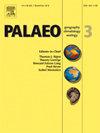全球珊瑚礁生长的巴约西亚事件:瑞士北部的记录
IF 2.6
2区 地球科学
Q2 GEOGRAPHY, PHYSICAL
Palaeogeography, Palaeoclimatology, Palaeoecology
Pub Date : 2024-09-13
DOI:10.1016/j.palaeo.2024.112504
引用次数: 0
摘要
在三叠纪-侏罗纪交界处以及普利恩巴赫期-托阿克期发生的大灭绝事件之后,珊瑚礁建造者受到了严重影响,中侏罗世早期珊瑚礁域的数量达到了历史最低点。然而,新的和更新的数据似乎表明,珊瑚比以前认为的更为广泛,特别是在巴约卡期(170-168 Ma),但缺乏生物地层标记来确定该时期珊瑚礁演化的确切时间。最近在瑞士北部特提斯北缘发现的一个 40 米厚的碳酸盐单元记录了这一快速增长。该单元的两个岩芯显示,珊瑚礁标本数量多,但珊瑚多样性低,年代为巴约西亚,很可能生长在相当深的水下(中生带上限或 20-30 米)。此外,它生长在富含粘土矿物的堆积层之上,地势较低。共鉴定出 12 个不同的珊瑚属,主要是 Periseris、Isastrea、Thamnasteria 和 Dendraraea。在缺乏其他生物地层标记的情况下,该研究利用古形态学提供了精确的年代测定,这表明古形态学是测定珊瑚礁沉积物年代的有力工具。研究结果表明,根据古植物学数据,巴约卡纪早期的绍泽(Sauzei)和汉弗莱西亚姆(Humphriesianum)氨石区内有暗礁生长,其年代与法国巴黎盆地东部和卢森堡同时测定的其他巴约卡纪暗礁地点的年代相似。这些结果表明,中侏罗世,更具体地说是巴约卡早期的最后两个氨虫区是适合珊瑚礁建造者的时期,全球珊瑚礁的重新生长比预期的要快。新的巴约卡珊瑚礁分布图显示,纬度低于 15°的地区没有珊瑚礁。这种分布模式可能是由于对珊瑚而言,赤道附近的水温过高(25 °C),阻碍了珊瑚礁的生长。这倾向于认为全球气候,特别是温度,是珊瑚礁生长的决定因素。本文章由计算机程序翻译,如有差异,请以英文原文为准。
A Bajocian event of global coral reef growth: Record from northern Switzerland
Following the extinction event at the Triassic – Jurassic boundary and during the Pliensbachian – Toarcian events, coral reef builders were severely affected, and the number of reef domains during the early Middle Jurassic was at an all-time low. However, new and updated data seem to show that corals were more widespread than previously thought, particularly during the Bajocian (170–168 Ma), but biostratigraphic markers are lacking to constrain the precise timing of reef evolution of this interval. A recently discovered 40 m-thick carbonate unit in northern Switzerland, on the northern Tethys margin, documents this rapid growth. Two cores from this unit display a reef with a high number of specimen but a low coral diversity, dated as Bajocian, which likely grew at a considerable water depth (upper limit of the mesophotic zone or 20–30 m). Additionally, it developed on top of clay mineral-rich accumulation characterised by low relief. Twelve different coral genera were identified, with a strong predominance of Periseris, Isastrea, Thamnasteria and Dendraraea. In the absence of other biostratigraphic markers, palynomorphs were used to provide accurate dating, which shows that palynology is a powerful tool for dating reef deposits. The results show reef growth during the early Bajocian, in the Sauzei and Humphriesianum ammonite zones, based on the palynological data, yielding similar ages to other Bajocian reef localities in the Eastern Paris Basin in France and Luxembourg dated simultaneously. These results indicate that the Middle Jurassic and more specifically the last two ammonite zones of the early Bajocian were periods suitable for coral reef builders, and that global regrowth of coral reefs occurred more rapidly than expected. A new Bajocian reef distribution is presented, showing no reefs at latitudes below 15°. This distribution pattern is probably due to the fact that water temperature was too elevated (> 25 °C) towards the equator for corals, which prevented reef growth. This would tend to favour a scenario in which the global climate, in particular temperature, is a determining factor for coral reef growth.
求助全文
通过发布文献求助,成功后即可免费获取论文全文。
去求助
来源期刊
CiteScore
5.90
自引率
10.00%
发文量
398
审稿时长
3.8 months
期刊介绍:
Palaeogeography, Palaeoclimatology, Palaeoecology is an international medium for the publication of high quality and multidisciplinary, original studies and comprehensive reviews in the field of palaeo-environmental geology. The journal aims at bringing together data with global implications from research in the many different disciplines involved in palaeo-environmental investigations.
By cutting across the boundaries of established sciences, it provides an interdisciplinary forum where issues of general interest can be discussed.

 求助内容:
求助内容: 应助结果提醒方式:
应助结果提醒方式:


